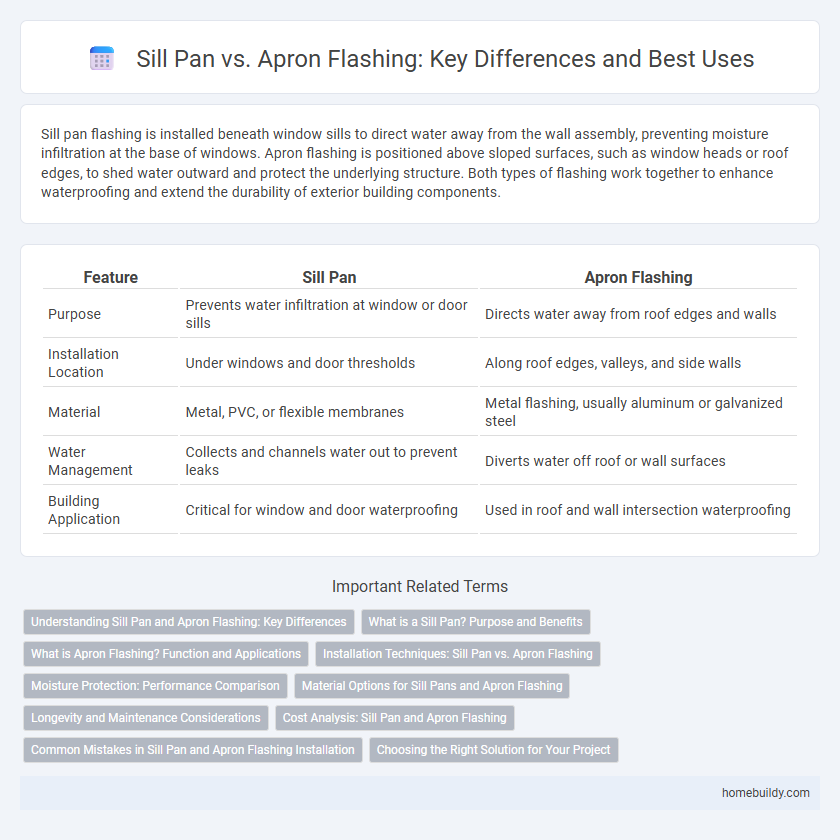Sill pan flashing is installed beneath window sills to direct water away from the wall assembly, preventing moisture infiltration at the base of windows. Apron flashing is positioned above sloped surfaces, such as window heads or roof edges, to shed water outward and protect the underlying structure. Both types of flashing work together to enhance waterproofing and extend the durability of exterior building components.
Table of Comparison
| Feature | Sill Pan | Apron Flashing |
|---|---|---|
| Purpose | Prevents water infiltration at window or door sills | Directs water away from roof edges and walls |
| Installation Location | Under windows and door thresholds | Along roof edges, valleys, and side walls |
| Material | Metal, PVC, or flexible membranes | Metal flashing, usually aluminum or galvanized steel |
| Water Management | Collects and channels water out to prevent leaks | Diverts water off roof or wall surfaces |
| Building Application | Critical for window and door waterproofing | Used in roof and wall intersection waterproofing |
Understanding Sill Pan and Apron Flashing: Key Differences
Sill pans are installed beneath window sills to direct water away from the wall, preventing moisture infiltration and structural damage. Apron flashing is placed above exterior window sills and extends outward to shed water away from the building facade. Unlike apron flashing, which primarily protects the upper sill area, sill pans are integral waterproofing components designed to catch and redirect any water that penetrates the window assembly.
What is a Sill Pan? Purpose and Benefits
A sill pan is a metal or plastic barrier installed beneath window or door sills to prevent water infiltration and protect the structure from moisture damage. It directs any water that penetrates the exterior back outside, reducing the risk of mold, rot, and structural deterioration. Compared to apron flashing, which covers the exterior face and deflects water away from horizontal surfaces, a sill pan focuses on sealing and draining from underneath the opening, providing a critical waterproofing layer.
What is Apron Flashing? Function and Applications
Apron flashing is a waterproofing component installed at roof-to-wall junctions or where roofs meet chimneys and other protrusions, designed to direct water away from vulnerable areas to prevent leaks. It functions by overlapping roofing materials and channeling water safely off the structure, thereby protecting the building envelope from moisture intrusion. Commonly used in roofing systems, apron flashing is essential for maintaining roof integrity and prolonging the lifespan of exterior walls and windows adjacent to roof edges.
Installation Techniques: Sill Pan vs. Apron Flashing
Sill pan installation involves carefully positioning a pre-formed or custom-fabricated waterproof tray beneath window sills to direct water away from the wall assembly, requiring precise sealing at the sides and back to prevent leaks. Apron flashing is installed above the window or door sill, integrating metal or flexible flashing materials that extend over the exterior wall, focusing on overlapping layers for redirecting water. Both techniques demand meticulous surface preparation and appropriate use of sealants, but sill pans concentrate on capturing water at the window base, while apron flashing primarily facilitates water shedding from above.
Moisture Protection: Performance Comparison
Sill pans provide superior moisture protection by creating a durable barrier that directs water away from window or door openings, preventing water intrusion and potential structural damage. Apron flashing, while effective at diverting water, primarily manages runoff above the sill and does not form a complete seal like sill pans. The integrated design of sill pans enhances overall moisture management by sealing gaps and protecting the substructure from prolonged exposure to water.
Material Options for Sill Pans and Apron Flashing
Sill pans are commonly made from materials such as PVC, aluminum, or stainless steel, offering strong waterproofing and durability against window leaks. Apron flashing typically utilizes aluminum or galvanized steel, providing a rigid yet flexible barrier to redirect water away from critical joints. Selecting materials depends on environmental exposure, with PVC preferred for corrosion resistance, while metal options excel in structural strength and UV resistance.
Longevity and Maintenance Considerations
Sill pans provide superior water drainage and longer durability compared to apron flashing due to their integrated design that prevents water intrusion at window and door sills. Maintenance demands for sill pans are generally lower since they resist mold and rot more effectively, reducing long-term repair costs. Apron flashing, while easier to install, often requires frequent inspections and repairs to maintain its protective function against water damage.
Cost Analysis: Sill Pan and Apron Flashing
Sill pans generally offer a more cost-effective solution compared to apron flashing due to their simpler installation and lower material expenses. Apron flashing, often made from metal, involves higher labor and material costs but provides enhanced durability and superior water protection in severe weather conditions. Evaluating project budgets alongside climate demands is essential for selecting between sill pans and apron flashing in building envelope construction.
Common Mistakes in Sill Pan and Apron Flashing Installation
Common mistakes in sill pan and apron flashing installation include improper sealing and overlapping, leading to water intrusion and structural damage. Failure to integrate the sill pan correctly with the weather-resistant barrier often results in leaks and mold growth. Overlooking the correct placement of apron flashing compromises drainage, causing water to accumulate and degrade the building envelope.
Choosing the Right Solution for Your Project
Selecting between a sill pan and apron flashing depends on your project's specific moisture management needs and installation context. Sill pans provide a comprehensive waterproof barrier beneath windows to prevent water intrusion at the sill, ideal for new constructions or major renovations. Apron flashing, while effective for redirecting water on exterior surfaces, lacks the full encapsulation of sill pans, making the latter the preferred choice for optimal water protection and durability.
sill pan vs apron flashing Infographic

 homebuildy.com
homebuildy.com